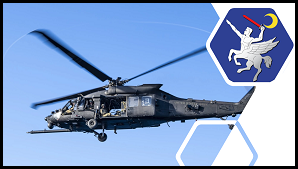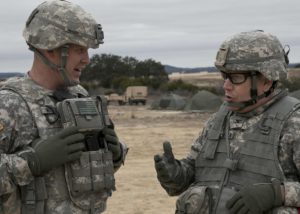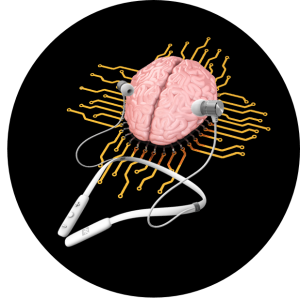“We see this as having great potential for just getting the right people in the right places and making individuals’ aptitude known to them.”
[Editor’s Note: Army Mad Scientist has extensively explored how Artificial Intelligence and Machine Learning (AI/ML) can be harnessed to enhance our Warfighters’ ability to fight at machine speed and sustain our decisive Soldier overmatch. But as frequent contributor COL Stefan J. Banach (USA-Ret.) has noted, the evolution and convergence of technologies has added a new non-kinetic battle space to conventional warfare, which in turn requires the recruiting and retention of adaptive Warfighters, with highly-tuned aptitudes for tactical innovation and rapid, decisive decision-making. The challenge facing the Army is how to effectively identify and then screen for these and other requisite talents.
Today’s episode of The Convergence podcast features our interview with Loran Ambs, Chief Technology Officer, Ideal Innovations, Inc., regarding his company’s research into measuring the distinctive characteristics of innate talent, identifying potential high performers, and how the Army can harness AI/ML to screen and match these high performers with specialty vocations — Read on!]
[If the podcast dashboard is not rendering correctly for you, please click here to listen to the podcast.]
 Loran Ambs serves as the Chief Technology Officer for Ideal Innovations, Inc. He supports the development and implementation of innovation processes at I-3 and DoD customer sites.
Loran Ambs serves as the Chief Technology Officer for Ideal Innovations, Inc. He supports the development and implementation of innovation processes at I-3 and DoD customer sites.  Mr. Ambs participates in the conception, development, and transition of technical solutions for problems affecting operations of the DoD and intelligence communities. He conducts basic and applied research into techniques using measures of brain activation for the discovery of traits, aptitude, knowledge, interest, familiarity, group association and compatibility applied to selection and assessment of individuals for in military, government, academic and commercial environments. Mr. Ambs is inventor or co-inventor of more than 30 issued U.S. patents including several related to brain activation matching, brain matched compatibility, and knowledge discovery.
Mr. Ambs participates in the conception, development, and transition of technical solutions for problems affecting operations of the DoD and intelligence communities. He conducts basic and applied research into techniques using measures of brain activation for the discovery of traits, aptitude, knowledge, interest, familiarity, group association and compatibility applied to selection and assessment of individuals for in military, government, academic and commercial environments. Mr. Ambs is inventor or co-inventor of more than 30 issued U.S. patents including several related to brain activation matching, brain matched compatibility, and knowledge discovery.
Mr. Ambs previously served as the on-site PM in Afghanistan for the installation and operation of stand-off biometric data collection, remotely operated ISR systems, wireless data communication, data fusion, aggregation and presentation capabilities leading to increased safety and effectiveness of our soldiers and coalition partners.  He served as the Chief Scientist for the Joint Improvised Explosive Device Defeat Organization (JIEDDO) in which he participated in the identification, acquisition, development, test, and transition of solutions for the detection, neutralization, and mitigation of IEDs. He collaborated with the DoD Service branches, DoD labs, National Labs, operational units, Congressional staffers, Defense Science Board, Army Science Board, National Academies, JASONS, industry, and academic institutions to focus the Nation’s resources on defeating IEDs.
He served as the Chief Scientist for the Joint Improvised Explosive Device Defeat Organization (JIEDDO) in which he participated in the identification, acquisition, development, test, and transition of solutions for the detection, neutralization, and mitigation of IEDs. He collaborated with the DoD Service branches, DoD labs, National Labs, operational units, Congressional staffers, Defense Science Board, Army Science Board, National Academies, JASONS, industry, and academic institutions to focus the Nation’s resources on defeating IEDs.
Army Mad Scientist sat down with Mr. Ambs to discuss his company’s research into measuring the distinctive characteristics of innate talent, identifying potential high performers, and how the Army can harness AI/ML to screen and match these high performers with specialty vocations (e.g., pilots, special operators, and other select duty positions). The following bullet points highlight key insights from our conversation:
-
-
- Training is expensive – it costs $13 million to train one F-35 pilot – so devoting resources to personnel who are not suited to a specific
 competency or MOS is wasteful. Looking at a prospective trainee’s brain activation response, and comparing the results to a successful pilot can identify those who are more likely to complete the training successfully.
competency or MOS is wasteful. Looking at a prospective trainee’s brain activation response, and comparing the results to a successful pilot can identify those who are more likely to complete the training successfully.
- Training is expensive – it costs $13 million to train one F-35 pilot – so devoting resources to personnel who are not suited to a specific
-
-
-
- Brain activation response through Electroencephalogram (EEG) is inexpensive, highly portable, and well understood. Other methods like
 Functional Magnetic Resonance Imaging (FMRI) may provide higher detail and fidelity, but it’s not practical for each trainee to sit through an FMRI scan. Multiple EEG headsets can be administered to trainees quickly and unobtrusively to gather data.
Functional Magnetic Resonance Imaging (FMRI) may provide higher detail and fidelity, but it’s not practical for each trainee to sit through an FMRI scan. Multiple EEG headsets can be administered to trainees quickly and unobtrusively to gather data.
- Brain activation response through Electroencephalogram (EEG) is inexpensive, highly portable, and well understood. Other methods like
-
-
-
- Mr. Ambs’ method was used with the 160th Special Operations Aviation Regiment to find a signature or baseline with which to
 compare their trainee data. Using a group of highly specialized aviators was deliberate in order to find a signature that would be vastly different from the general population.
compare their trainee data. Using a group of highly specialized aviators was deliberate in order to find a signature that would be vastly different from the general population.
- Mr. Ambs’ method was used with the 160th Special Operations Aviation Regiment to find a signature or baseline with which to
-
-
-
- The data processing and pattern recognition powers of AI/ML can be harnessed to “crunch” EEG scan data to correlate brain activation
 responses and help identify signature markers for aptitudes associated with specialty vocations.
responses and help identify signature markers for aptitudes associated with specialty vocations.
- The data processing and pattern recognition powers of AI/ML can be harnessed to “crunch” EEG scan data to correlate brain activation
-
-
-
- Beyond identifying aptitudes for specific trainings or vocations,
 creating a large library of brain activation responses allows for comparisons to be made and outliers to be recognized. This means no brain scan goes unused, and personnel can be grouped even if conducted for a different training.
creating a large library of brain activation responses allows for comparisons to be made and outliers to be recognized. This means no brain scan goes unused, and personnel can be grouped even if conducted for a different training.
- Beyond identifying aptitudes for specific trainings or vocations,
-
-
-
 Brain activation response monitoring is dynamic. If successful, this technology and method of evaluation could transcend Army Professional Military Education (PME) and training and be used to identify specific aptitudes in the Government writ-large, academia, and the private sector.
Brain activation response monitoring is dynamic. If successful, this technology and method of evaluation could transcend Army Professional Military Education (PME) and training and be used to identify specific aptitudes in the Government writ-large, academia, and the private sector.
-
-
-
- This is not designed to exclude or deny anyone training.
 It is designed to assist in identifying innate capabilities and align strengths and weaknesses with the best opportunities for success. It is one piece of data at a more granular level to help decision-makers make better decisions.
It is designed to assist in identifying innate capabilities and align strengths and weaknesses with the best opportunities for success. It is one piece of data at a more granular level to help decision-makers make better decisions.
- This is not designed to exclude or deny anyone training.
-

Stay tuned to the Mad Scientist Laboratory for our next episode of The Convergence podcast on 28 September 2023.
If you enjoyed this post, check out the following related content:
It’s All In Your Head: How The Brain Makes Better Soldiers and associated podcast, with Zach Schonbrun
Go with the Flow: Enhancing Human Cognition and associated podcast, with Dr. Maria Kozhevnikov
Making Quick Decisions, Quicker! and associated podcast, with proclaimed Mad Scientist Jason Sherwin
The Future of Learning: Personalized, Continuous, and Accelerated
Fight Club Prepares Lt Col Maddie Novák for Cross-Dimension Manoeuvre, by then LTC Arnel David, U.S. Army, and Major Aaron Moore, British Army, along with their interview in UK Fight Club – Gaming the Future Army and associated podcast
The Last Frontier, by PFC Peter Brenner
>>>>ANNOUNCEMENT: The U.S. Army War College is preparing for the Third Annual Strategic Landpower Symposium on 7-9 May 2024.
Last year’s Second Annual Strategic Landpower Symposium included several general officer speakers. GEN Flynn, CG, USARPAC, was our Keynote speaker; GEN Hokanson, Chief, National Guard Bureau, was a guest speaker; and LTG Bernabe, CG, III Corps, was our Capstone speaker among seven other general officer speakers and panelists. Videos of this event can be found here and on the Strategic Landpower Symposium website.
Last year, we received 26 papers from the military academic community, including several submissions from foreign allied and partner officers and were able to select eight for publication through Marine Corps University Press. These selected papers are in the final stages of publication and will be available at the 2024 Strategic Landpower Symposium.
 Check out the Call for Papers flyer for next year’s symposium, providing the event’s themes, proposed abstract submission guidelines/suspense, and paper submission guidelines/suspense. For additional information about the Symposium, click here.
Check out the Call for Papers flyer for next year’s symposium, providing the event’s themes, proposed abstract submission guidelines/suspense, and paper submission guidelines/suspense. For additional information about the Symposium, click here.
Disclaimer: The views expressed in this blog post do not necessarily reflect those of the U.S. Department of Defense, Department of the Army, Army Futures Command (AFC), or Training and Doctrine Command (TRADOC).



